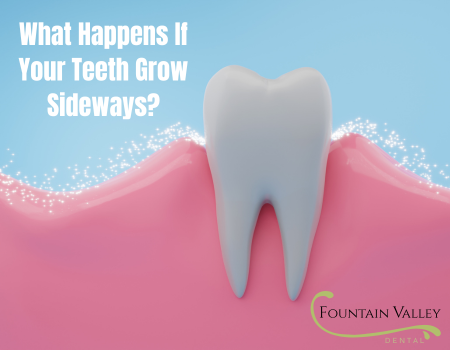Teeth are designed to align properly within the jaw to facilitate chewing and maintain overall oral health. However, several factors can contribute to misalignment, resulting in teeth growing sideways. This condition, commonly referred to as malocclusion, can have significant implications for your dental health, appearance, and even your self-esteem. Understanding the potential consequences of sideways-growing teeth and exploring available treatment options is crucial.
Causes of Sideways-Growing Teeth
Several factors can contribute to teeth growing sideways, leading to malocclusion:
 Genetics: Genetics play a substantial role in determining the size and shape of your teeth and jaw. If your parents had misaligned teeth, you’re more likely to encounter similar issues.
Genetics: Genetics play a substantial role in determining the size and shape of your teeth and jaw. If your parents had misaligned teeth, you’re more likely to encounter similar issues.- Early Tooth Loss: Losing baby teeth prematurely due to decay or injury can disrupt the natural alignment of adult teeth as they erupt.
- Thumb Sucking and Oral Habits: Prolonged thumb sucking, pacifier use, or other oral habits during childhood can affect the alignment of developing teeth and jaws.
- Jaw Size: A mismatch between jaw size and tooth size can lead to overcrowding or spacing issues, resulting in sideways tooth growth.
- Dental Trauma: Injuries to the mouth can displace teeth or affect their growth patterns, causing them to shift sideways.
Consequences of Sideways-Growing Teeth
Having teeth that grow sideways can lead to various issues that impact both your dental health and overall well-being. Some common consequences include:
- Chewing Difficulties: Teeth that are not properly aligned can make chewing difficult. Malocclusion may result in an uneven bite, causing certain teeth to bear more pressure than others. This can lead to discomfort or pain when chewing, making it challenging to enjoy a balanced diet.
- Increased Wear and Tear: Teeth that are misaligned can cause uneven wear on their surfaces. When teeth do not come together correctly, some may experience excessive grinding or chipping, which can weaken the tooth structure over time. This can increase the risk of cavities and require restorative treatments.
- Jaw Pain and Discomfort: Malocclusion can also contribute to jaw pain and discomfort. The muscles responsible for jaw movement may become strained due to an uneven bite, leading to temporomandibular joint (TMJ) disorders. Symptoms of TMJ disorders include jaw clicking, headaches, and facial pain, which can significantly affect quality of life.
- Gum Disease Risk: When teeth are misaligned, it can be more challenging to maintain proper oral hygiene. Overcrowded or crooked teeth create difficult-to-reach areas where plaque and tartar can build up. This can lead to gum disease, which may progress to tooth loss if not addressed promptly.
- Self-Esteem Issues: Aesthetic concerns related to crooked or misaligned teeth can significantly impact self-esteem and confidence. Individuals may feel embarrassed to smile or speak in social situations, which can affect their personal and professional relationships.
Treatment Options for Sideways-Growing Teeth
If you’re experiencing issues with sideways-growing teeth, several treatment options can help address malocclusion:
- Orthodontic Treatment
Braces and clear aligners (like Invisalign) are common solutions for correcting misaligned teeth. An orthodontist will assess your specific case and create a treatment plan to gradually shift your teeth into the proper position.
– Braces: Traditional metal braces involve brackets and wires that apply gentle pressure to move teeth over time. This option is highly effective for complex cases.
– Clear Aligners: For those seeking a more discreet option, clear aligners offer a removable and less noticeable alternative to traditional braces.
- Dental Veneers
For individuals with minor misalignment, dental veneers can improve the appearance of teeth. These thin shells are custom-made and bonded to the front surface of your teeth, providing an instant cosmetic fix.
- Dental Crowns
In cases where teeth have been worn down or damaged due to misalignment, dental crowns can restore their shape and function. Crowns offer added strength and protection while also improving appearance.
- Retainers
After orthodontic treatment, wearing a retainer helps maintain the new alignment of your teeth. Retainers are essential for preventing teeth from shifting back to their original position.
If your teeth are growing sideways, it’s essential to seek professional dental advice. The consequences of misalignment can extend beyond aesthetics, affecting your oral health and quality of life. Understanding the causes and potential complications can help you make informed decisions about treatment options.
If you’re concerned about sideways-growing teeth, consider reaching out to the experts at Fountain Valley Dental. Their team can assess your situation, provide tailored recommendations, and guide you toward achieving a healthier, more confident smile. Don’t let misalignment hold you back—take the first step towards a straighter smile today!